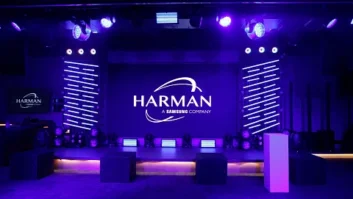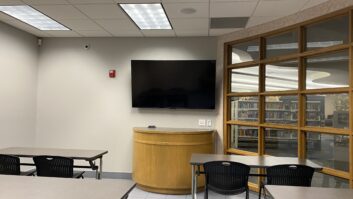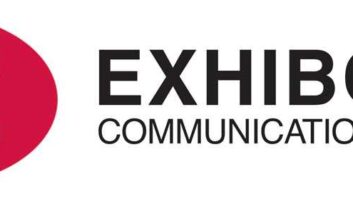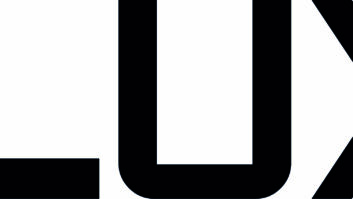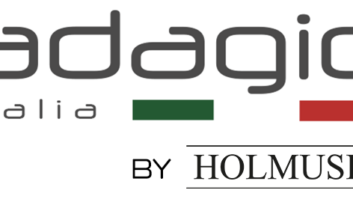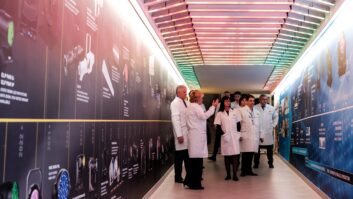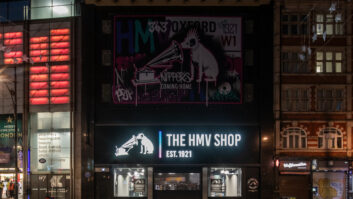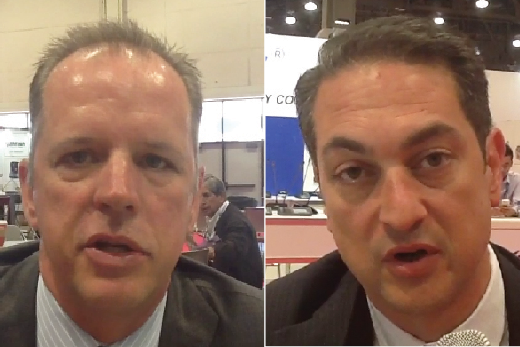
At a press conference at the start of InfoComm, it was announced that the acquisition of AMX by Harman had been completed. Later that morning, Paddy Baker sat down with Blake Augsburger, president of Harman Professional, and Rashid Skaf, president and CEO of AMX, to discuss the implications of the deal for the companies and for the market.
In the press conference, Blake, I think you said that Harman has a total audio-video strategy, or possibly audio-video-lighting strategy? When does that date from?
Blake Augsburger: We’ve been talking about an AV system solution for 10 years. When we bought Martin, there was a whole bunch more to it than just live events. We bought them for the growth opportunities on the installation side. Simplistically, they take a string of LEDs and wrap a building or a bridge in it, and each LED becomes a pixel – and they can run video across what is basically a big screen.
So you think about AV and really Martin starts to play a large part in that. As we grow that business, we’re going to be doing more of this architectural stuff – and you’re going to have AMX controlling and conditioning signals that are going to end up being shown on both a Martin light and , say, a Samsung flatscreen.
That’s why I threw in the ‘L’. It really is an AV strategy, but if you put in the L people ask about it and I can talk about Martin!
VIDEO: Watch the two company presidents discuss the implications of the acquisition for systems integrators here:
[brightcove videoid=”3655063422001″ playerid=”3033416250001″ height=”270″ width=”480″]
Will there be further acquisitions on the display side?
BA: I can’t talk about that, but if you look at where we started, it was with a pro audio system solution, and that sold very well because it was all about the user experience. Now we’re going to talk about a parallel path, which is video, and we want to provide a full video solution and then bring them together for an AV solution. So you start thinking, what am I missing in this video solution? That will kind of give you an idea of the things that we look at and talk about.
But to do a deal, you’ve got to have to have a buyer and a seller. I’ve known Rashid ten years, we’ve been talking about this for a long time, and the timing was never right for either party. Now we’ve got lucky because of the timing.
Rashid, AMX went on the acquisition trail a few years ago and bought a number of brands that widened its reach into different markets. Those brands have been subsumed into AMX, which is now a more diverse brand than many of the other Harman brands it now sits alongside. Is there any scope for unpacking some of those AMX-acquired brands again?
Rashid Skaf: We had to completely pivot the company about eight years ago. We saw four trends: audio and video being everywhere; video being the communication path that people wanted to follow; the fact that people would be using personal communication devices – this predated the iPad – to access data from the Cloud whenever they needed; and sustainability. As we acquired these companies it was about building a platform to combine all these things to come up with new solutions. Last year almost 70% of our revenue came from products that didn’t exist three or four years ago – and for a 32-year old company that’s pretty amazing.
What we really see now is not unpacking the brands again to go into Harman, but – and we’re two-and-a-half days into this, so we still have a few things that are not quite worked out yet – I would like to see some of our technologies under brands that someone in the professional audio channel would want to buy, such as a controller by Harman, or a controller by JBL. Or somebody wants to buy a speaker, and that becomes part of what we do. Blake’s vision has always been a complete solution, and we’ll become part of that – whether as a brand or as part of a different brand, it’s really not that important. It’s about solving people’s problems rather than what it says on the box.
BA: Having lots of brands is difficult to manage – it’s expensive; if Harman could figure out how to do it with one brand, they would. What really makes a brand worth keeping, worth talking about, is credibility. AMX gives us huge credibility in video – customers know what the quality is going to be, they know what to expect.
So AMX will still exist in its own right for people who want the current line-up of solutions, but elements of the technology will be rolled into the other brands?
BA: Look at the Harman booth, you can see how we display the brands: it’s Martin by Harman, so it’ll be AMX by Harman. AMX is our video brand.
RS: And vice versa – we have audio DSPs and amplifiers in our product line. I’d rather have them under the Crown brand because we’re not an audio company. And that’s the beauty of this: what we’re really strong at Harman traditionally hasn’t been, and what they’re strong at, we’re not. So together we bring real great strength across the board.
The really exciting part is the amount of innovation that can happen across the brands. It’s not just about expanding into these verticals or into those product lines, but what innovation can we have together that will leapfrog us into a whole new segment of the market that we’re not in as an industry. Those are the kind of innovations that I look forward to under Blake’s leadership.
BA: There are all sorts of opportunities here that are unexplored – I think Rashid tagged it by saying it’s the technology innovation that’s going to open up new doors.
So there is going to be a cross-functional team to explore how the two companies are going to work together. What will they be tasked with doing?
BA: We’ll have a team that focuses on sales, and they’ll talk about cross-selling and vertical market opportunities. And then we’ll have a team that’s focused on technology. We have a lot going on in Salt Lake City with our signal processing business unit, and there’s a lot going on in Dallas with video processing and signal processing there. We’ve got to bring these two teams together and let them look at it and say, “I got something here in my pocket that’s going to make this product a little bit better” – or “We’ve been spending millions of dollars trying to design this product that you’ve already got in your stable.”
Those are the two biggest parts – then there’s the operational stuff which is pretty straightforward: like changing systems, email, putting our buyers together. The new procurement structure will bring advantages to systems integrators as we will be able to make better product cheaper. That will make us more competitive and ultimately make them more competitive too.
RS: We’ve done this ourselves three times as well – we’ve been on the other side of it, so the process is pretty seamless. As Blake says, sales is really the first frontier of where we’re going to get this benefit. Technology takes a little longer time – much as we would like it to happen overnight.
How is IDX [Harman’s information delivery system] faring in Europe, and what can AMX bring to the party here?
BA: It’s been very successful in transportation and hospitality. If you look at an IDX system, for me it’s the ability to sell all the speakers and the amplifiers tagged to that that makes it so important. The server, software and routing are just a small component. Again, this is early, but Rashid showed me some of the IDX-type jobs that they’ve done – so we have these two solutions that we might be able to merge and make something even better.
RS: Network Rail in the UK is one of our customers here – it’s very similar to what has been done through IDX. I think there’s a great opportunity.
BA: We’ve focused on the audio part of the information delivery – paging, sequencing of paging and the life safety aspects – with video as secondary. Rashid’s video is his first thought and his audio is secondary. If you put them together we could have a really cool solution going forward.
RS: You can see why we’re so excited about this, because every single opportunity we uncover, we’re peeling the onion and with every layer we’re saying: “That’s perfect – they just go together.”
BA: The thing that I remind myself a lot is, we sell to professionals who use our products to make money for themselves. So anything we can do to cut their costs, or simplify the operation or the user experience, we’re going to win – and they’re going to win because they can make more money. Bringing all this together, we’re going to get more of those opportunities popping up.
It’s amazing how the cultures in our businesses are almost identical – the guys think alike, they even look alike! – it’s a perfect cultural mix.
Did you see the InfoComm opening keynote last night? [Futurologist] Mike Walsh said: “If your company is a platform, culture is the operating system.”
RS: We’ve talked about this. Obviously your culture is what drives you to work each day. There are now plenty of opportunities these days for people to find a job somewhere else which maybe they didn’t have two or three years ago with the economy as it was. So you have to create an environment where people have a passion and they want to come and do great things. That’s what we’ve tried to do and I think Harman has a similar culture.
How has the news been received within the two companies?
BA: Unbelievable. I’ve not heard a negative comment, to be honest with you. You normally hear some. We had a talk last night with the two sales teams – they all seem really excited. Usually the guys who get nervous are the distributors, but even they are coming up and saying “Man, this is awesome” – because there’s not a lot of overlap and people see it as an opportunity to grow.
RS: It’s been incredibly positive across the board. Our employees have looked at this from day one – I spoke to all of them around the world – and they view it as a great opportunity to take AMX to the next level.
We were public – we had a great owner when we went private, but they were a bank, they didn’t understand our business day in and day out. I think our employees are interested to see our new owner is someone in our industry – they’re with us, they get to fight the same battles as us. And our engineers are thrilled, as they get to play with a bigger toy box.
When can we hope to see the first jointly developed Harman-AMX products?
BA: As Rashid said, it takes a while to design products. You’re probably looking at a couple of years before you see something material.
RS: If you look at our history, that was about the timeframe to see something material after an acquisition. We have a roadmap of products that we’ve announced – so we have to complete those as we look at how this mission is going to happen. For something that makes you say, ‘Wow, that’s it, I get it now”, 18 to 24 months is probably realistic.
BA: We want to bring something that’s very innovative and disruptive to the market. We want to change that whole experience for our customers.
What’s the opportunity that you’re each most excited about?
BA: From my side, looking at early wins; I think boardrooms, education and government installations are very exciting. There’s a big opportunity on the audio side.
RS: I’d say exactly the opposite: the stadiums, the houses of worship, the hotels – where we don’t do such a good job. It’s not that we don’t do anything in stadiums – or Harman doesn’t do anything in government – but it’s not our main focus. I would like to see that become a much bigger part of what we do globally.
BA: I met a big AMX dealer this morning, doing a big job with a ton of AMX and a ton of audio – none of it was Harman. I asked why, and he said, “Nobody really came to see me.” There’s no reason why these guys aren’t using each other’s products, it’s just that we aren’t touching those people. We’re going to get that business pretty quickly.
